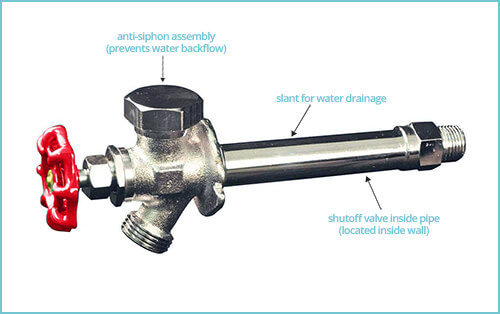Frost-Proof Faucet - Do You Need One?


What is a Frost-Proof Faucet and Why Do You Need One?
A modern frost-proof faucet has several important features including, the obvious, that it is cold-weather protected. While more expensive than a standard outdoor faucet, a frost-proof spigot will likely last much longer than standard spigots, which are prone to expanding and cracking in colder climates.
Frost-proof faucets provide the following benefits:
- Reduce risk of pipe bursting from frozen water.
- Extend inside home far enough to escape frostline.
- Prevent backflow of contaminated water into your home water system.
- Eliminate the need to bleed off water in the line each season.
How Frost-Proof Spigots Work
Frost-proof spigots have a deep-seated, water-shutoff valve not found on old-style, standard faucets. Old-style faucets had valves that tended to freeze as they were located outside of the home. Frost-proof systems house the valve further up the pipe (ideally, inside the house wall—away from the frost). The vacuum, or anti-siphon assembly is what prevents water from your hose backing up into the line and your home water supply. So, while these are marketed as frost-proof pipes (accomplished by this additional feature), many homeowners aren’t aware of the bonus benefit (clean water), provided you buy the type with the anti-siphon assembly.
Frost-proof spigots come in a range of lengths to extend into your home. Ideally, even if you have a frost-proof spigot, you still want to install a dedicated shutoff valve inside your home. While the spigot will do its work without a shutoff, the shut-off provides one more barrier during winter, but, more importantly, makes it easier to change out the spigot should it become defective in the future. Without the shut-off valve, you’d have to turn off the entire water supply, which might send debris into your system when you turn it back on. Ideally, you always want a shut-off valve near every water supply in your home.
Even with a frost-proof spigot, you still need to take the usual safety precautions against freezing. The most important thing to remember is to disconnect your hose when the weather turns cold and allow existing water to drain from the pipe. Leaving hoses connected is the single most common cause of outdoor faucet failure.
Most new residential homes are built with these installed and some housing codes require them, but if you are building a new home, you should bring it up with the contractor. Another feature you might want, depending on your locale, is having locks installed on the spigots. If you are replacing a spigot, however, it’s definitely worth the money to install a frost-proof spigot with a vacuum assembly.
A properly-installed and maintained faucet should enjoy a long life. The biggest causes for premature failure of spigots are leaving the hose attached during winter and improper slope of the pipe in installation, which causes water backflow into the system.
How Much Do Frost-Proof Spigots Cost?
 They vary from manufacturer to manufacturer. Also, the longer the pipe, the higher the cost. A range would be $25-$60. You want to buy the ones with the vacuum breakers. How long you need will be determined by wall thickness. You can install these with a DIY connector kit, such as a SharkBite kit, but you might want a more permanent solution, which requires pipe brazing. Know that getting it the right length through a wall can be a bit tricky. A professional can give you installation quotes and most stock the frost-free faucets. Expect to pay between $120 and $160 per installed faucet.
They vary from manufacturer to manufacturer. Also, the longer the pipe, the higher the cost. A range would be $25-$60. You want to buy the ones with the vacuum breakers. How long you need will be determined by wall thickness. You can install these with a DIY connector kit, such as a SharkBite kit, but you might want a more permanent solution, which requires pipe brazing. Know that getting it the right length through a wall can be a bit tricky. A professional can give you installation quotes and most stock the frost-free faucets. Expect to pay between $120 and $160 per installed faucet.
The takeaway: Frost-proof outdoor faucets with vacuum breakers provide two benefits to homeowners: prevention against freezing and backflow contamination from hose backups. While more expensive than standard spigots, they’ll outperform and outlast standard sill cocks, saving you money in the long run.
Lastly, if you live on a slab or have a cold entry point, you definitely need the vacuum breaker, but you may also want to consult a professional for advice on preventing your pipes from freezing. Also, read our related article on winterizing your home.
- Tip 1: Save money on plumbing jobs by consolidating smaller jobs, thus reducing the service/travel charge.
- Tip 2: Frost-proof pipes should be installed at a slight angle for proper drainage. Your plumber should know this.
- Tip 3: Sill cock, outdoor faucet, hose bib, and hose spigot all generally refer to the same thing.
